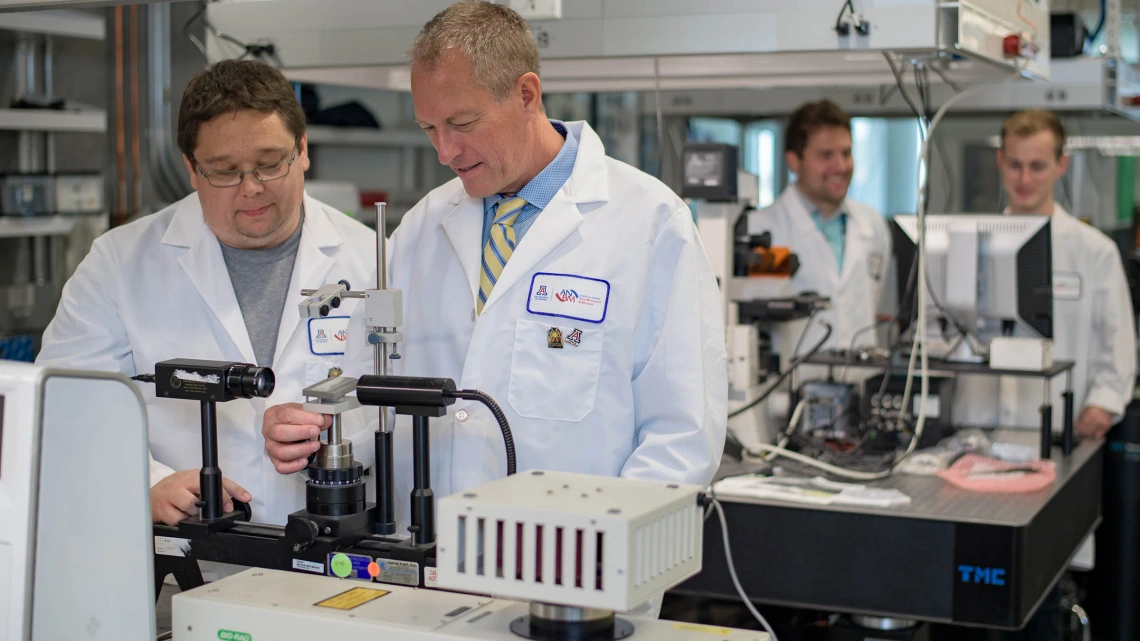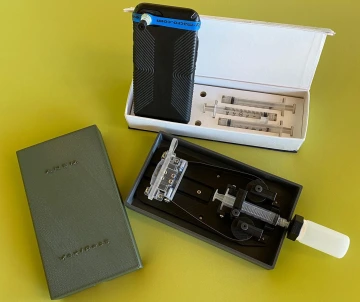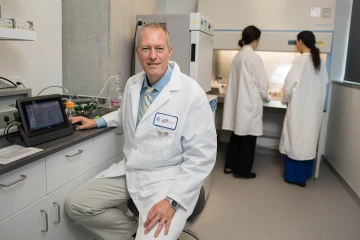Developing Rapid Diagnostics for Soldiers and Astronauts
Frederic Zenhausern, PhD, MBA, leads a team developing portable technology to detect a range of health problems in a matter of minutes.

In this 2017 photo, Frederic Zenhausern, PhD, MBA, right, director of the Center for Applied NanoBioscience and Medicine, works with Matthew Barrett, a senior research specialist.
When Frederic Zenhausern, PhD, MBA, was in college, he made the switch from biochemistry to physics. That transition continues to inform his work at the University of Arizona Health Sciences to create personal testing devices to help people learn about their health and their exposure to biothreats.

Associate Professor Jian Gu, PhD and Frederic Zenhausern, PhD, MBA, in their lab where they work together on a Department of Defense contract. Peng Chen, PhD, was a postdoctoral researcher in the lab until Oct. 2018.
Now, as director of the Center for Applied NanoBioscience and Medicine he works to pair high-tech diagnostics with handheld technology. Dr. Zenhausern hopes to make rapid tests for a wide range of health conditions more accessible — which could have applications from Earth to outer space.
A new portable test
The current at-home testing technology for pregnancy or HIV infection is called an immunoassay. The device uses urine or blood on the surface of a paper strip to determine if a specific hormone or virus is present. The Zenhausern Lab is developing a vertical flow immunoassay, which can reveal multiple biomarkers for a wider range of conditions, instead of just looking at one target biomarker.

The handheld device Frederic Zenhausern, PhD, MBA, is creating to help detect exposure to biohazards.
A device, such as a smartphone with a special attachment to its camera, will take a picture of the array of spots that detect the biomarkers. The image then can be analyzed by an algorithm, and in less than 15 minutes, it can show whether the individual has any of the biomarkers.
“It’s much faster and more sensitive,” Dr. Zenhausern explained, adding that the technology could potentially be used for early detection, when a biomarker is still in low concentrations in a fluid sample.
Testing biothreats on Earth and radiation in space
With funding from the Department of Defense, Dr. Zenhausern’s team is developing a vertical flow immunoassay diagnostic test that interfaces with a smartphone and can be used on the battlefield. Users would take blood or urine into a syringe and push the fluid onto a test strip. The device would take a picture of that paper membrane, telling users if they have been exposed to pathogens such as those that cause anthrax or plague.
“An individual in a combat zone or a first responder in the field could know within minutes if they have — or were exposed to — a serious pathogen or biothreat,” Dr. Zenhausern said. “We want the brave individuals serving on the front lines to be safe.”
Working with NASA, the Zenhausern Lab has also sent this technology into outer space to improve diagnostics for radiation exposure in astronauts. With a drop of blood and a handheld device, the assay can check a variety of genes.
“Genes can be a good signature of your exposure to radiation,” Dr. Zenhausern said. “We can learn the dose at which you have been exposed, and the kind of radiation you have been exposed to. The goal was to fully automate a vertical flow system in space, to monitor radiation exposure for astronauts when they go on deep space mission, for example to Mars.”
The need for speed
When the COVID-19 pandemic hit, the Zenhausern Lab received funding to extend the development of its space-based health monitoring system to build a prototype for COVID-19 testing.

Frederic Zenhausern, PhD, MBA
Dr. Zenhausern said there hasn’t been much investment by industry in rapid diagnostics.
“COVID has completely changed the landscape,” he said. “Through this technology, we could deliver point-of-care diagnostics in a parking lot, hospital emergency room, in an outpatient clinic and at a pharmacy, or even at home, that could be completed in several minutes and deliver secure results. As cases of the virus continue to increase across the globe, specifically in Arizona, the need for a rapid diagnostic test for the COVID-19 virus is crucial.”
Using physics to solve problems in health combines Dr. Zenhausern’s intellectual passions with his personal values.
“I am driven by the fact that I like to have an impact on society,” Dr. Zenhausern said. “I like to do things that people can use, and that ultimately have benefit. We want to improve quality of life.”

